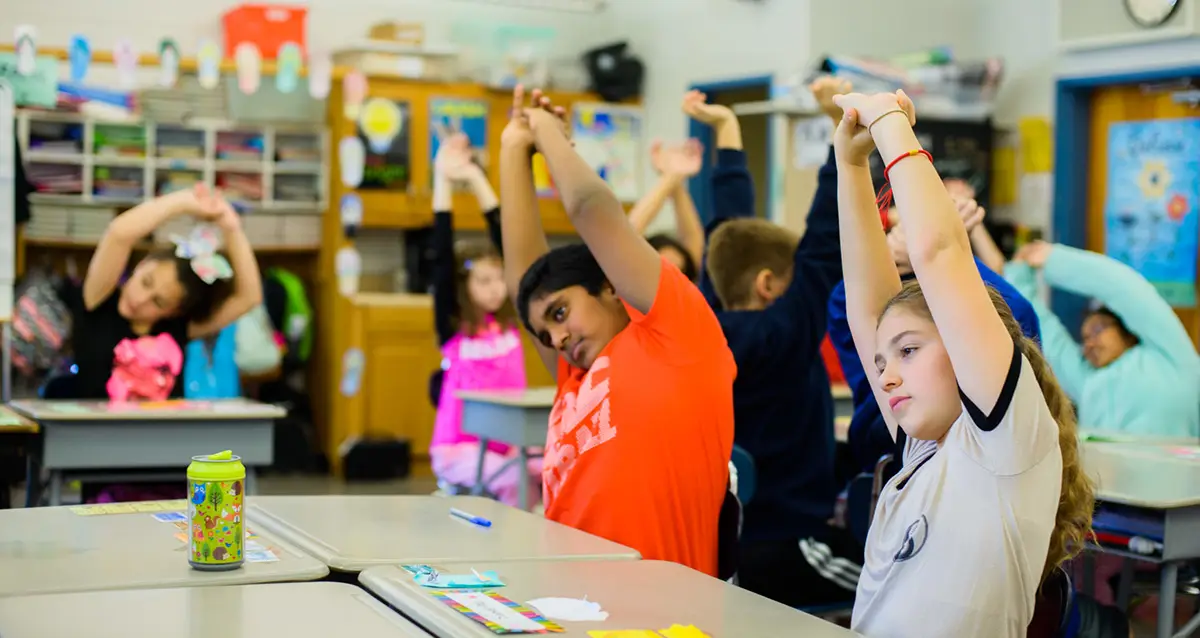
|
Check out our brand new product-- Yoga 4 Classrooms Tee! Wear Your Mindfulness With Pride!
|

Tuesday, January 10, 2017 (Updated July 2021)
As more schools around the country start adding yoga and mindfulness practices to their curricula, there is also a growing stream of positive media attention. Most recently, the popular Yogaglo blog (now glo.com) published an article titled, Yoga for School Kids, written by Alice Walton. Alice is also responsible for the recently published Forbes article which touted the scientific benefits of meditation for children’s brains and behavior, a notable read.
Yoga 4 Classrooms founder and CEO, Lisa Flynn, first met Alice at the first annual Yoga in the Schools Symposium held at Kripalu back in 2014. As a health and science writer, she was inspired to learn more about the tremendous impact yoga and mindfulness integration at school can have on the health and performance of schoolchildren and educators, as well as on school climate. Lisa had been following her writing since that time and was thrilled to hear from Alice a couple of months ago as she was gathering content for these articles. Her initial question: How does yoga and meditation in school support social and emotional growth and kindness? As it ends up, their communications focused on the seemingly endless trickle-down effects that regular yoga and meditation practices can have on individual students, educators and the school culture as a whole:
“It goes without saying that emotionally and physically healthy kids who feel safe, supported and connected are happier and more successful in and out of school,” says Lisa Flynn, founder of Yoga 4 Classrooms. “A growing body of evidence is demonstrating yoga in schools promotes the development of social, emotional, and physical well-being of school children (and teachers) as it fosters a positive, compassionate school climate, all of which are key for effective teaching and learning.”
When kids are more centered and more attentive, this can open up the way for academic changes to occur. And it’s the potential for academic benefits that may initially prompt the schools to make the leap into offering yoga – but the fuller range of benefits will of course be there, as well. “With social-emotional changes in place, we begin to see improvements in the areas of academic achievement, and decreases in behavior referrals,” says Flynn. “These are the areas that may be of most interest to school administrators who are just starting to explore yoga for their schools.”
| Cookie | Duration | Description |
|---|---|---|
| cookielawinfo-checkbox-analytics | 11 months | This cookie is set by GDPR Cookie Consent plugin. The cookie is used to store the user consent for the cookies in the category "Analytics". |
| cookielawinfo-checkbox-functional | 11 months | The cookie is set by GDPR cookie consent to record the user consent for the cookies in the category "Functional". |
| cookielawinfo-checkbox-necessary | 11 months | This cookie is set by GDPR Cookie Consent plugin. The cookies is used to store the user consent for the cookies in the category "Necessary". |
| cookielawinfo-checkbox-others | 11 months | This cookie is set by GDPR Cookie Consent plugin. The cookie is used to store the user consent for the cookies in the category "Other. |
| cookielawinfo-checkbox-performance | 11 months | This cookie is set by GDPR Cookie Consent plugin. The cookie is used to store the user consent for the cookies in the category "Performance". |
| viewed_cookie_policy | 11 months | The cookie is set by the GDPR Cookie Consent plugin and is used to store whether or not user has consented to the use of cookies. It does not store any personal data. |